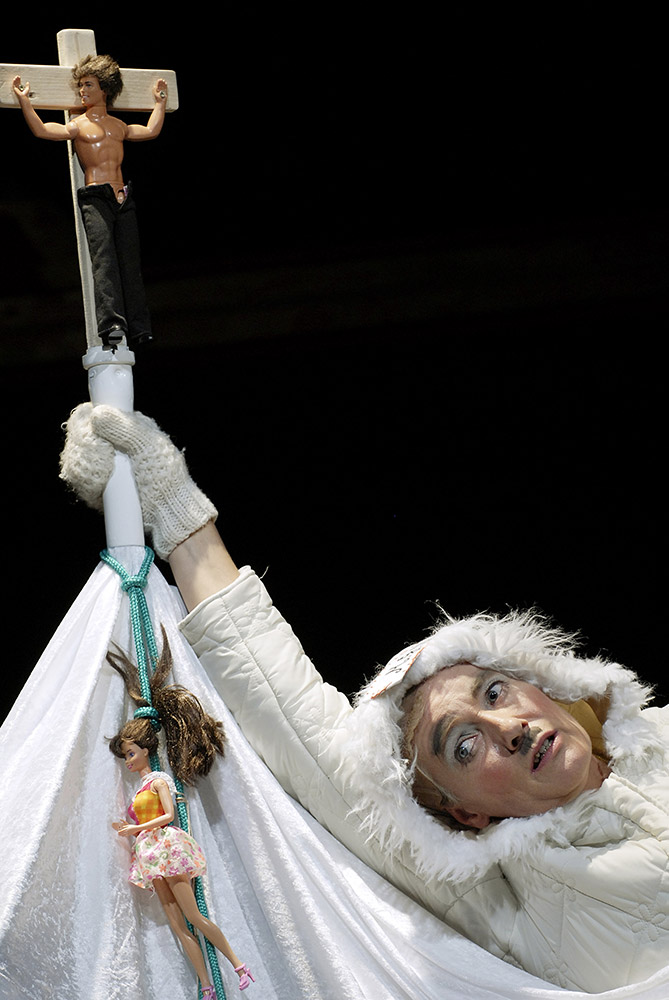Why the child is cooked in the polenta
At the circus people smile when they are dying
by Aglaia Veteranyi
with: Aglaia Veteranyi
Directed and stage design by: Nik Guenther
Costumes: Barbara Drosihn
Assistant: Uschi Mierzowski
Content:
The life of the family of artistes, reflected by Aglaja Veteranyi from personal experience in her first novel “Why the child is cooked in the polenta” may seem wild and lurid, but is dangerous and close to death throughout.
”It is the most astonishing book I have come across in recent years. An artiste on the high-wire writes and I watch from below and catch my breath”, Peter Bichsel wrote on the highly appraised novel. Three years after publication Aglaja Veteranyi commits suicide in Zurich at the age of 39.
From the perspective of a little girl the authoress tells the story of her family who had fled dictatorial Romania. The child only knows the home country by its smells. With a large suitcase the father, mother, aunt, sister and young narrator saunter through the rich Western European countries. Always strangers and always on the road.
“We must not become fond of anything“. Only the caravan offers a little piece of home for the family of artistes. “I open the caravan door as little as possible, so that home doesn’t evaporate.” Night after night the mother hangs from her own hair in the big top and juggles with fire torches. Night after night the daughter is scared to death. “I wait all day for night time to come. If my mother doesn’t fall from the dome, we will eat chicken soup after the show.” To distract and calm the little one in the caravan, the older sister tells her the story of the child cooking in the polenta.
Aglaja Veteranyi describes a circus of tender cruelty, the wayward world views of an uprooted child and the shattered dream of a better life in the West: “My mother says, everything is better here and cries.” In sensual scraps of poetry and a myriad of grotesquely exploding images Aglaja Veteranyi depicts a world in which sadness and laughter are not only close together but collide in one instant: “At the circus people smile when they are dying.”
Press
Video
Downloads
Critics
“We watch through a child’s eyes – animals jumping through hoops, illusionists halving women. But this time it’s all different: Gilla Cremer slides into the role of a circus girl – in her solo performance “Why the child is cooked in the polenta”, adapted from the novel by Aglaja Veteranyi and put on stage at Sprechwerk. At first the actress’s dog doughtily jumps through the hoop, but the make-believe circus world disintegrates soon. The music ends abruptly; Gilla Cremer begins with the narrative theatre play.
Gilla Cremer and her director Nik Günther draw us into the story of the circus girl – with few stage props and great acting skills. Cremer manages to perform a small miracle, she allows theatre appear in our own minds. A tragicomical and touching evening.” br> (Hamburger Morgenpost)
„With amusing tricks and a curly wig Cremer starts the one-woman-show, fawningly adored by her Jack Russell terrier Gypsy. Behind the cheap glitter she sensitively, humorously and poetically brings back to life the early years of the authoress and fellow actress, overshadowed by fear and death, who committed suicide in 2002.
Even the awkward balancing act of playing a child Cremer manages without slipping. Although she narrates from the child’s perspective she remains true to herself and her own voice, leaving space for the rich imagery of the text, acts with ironic alienation in clear and simply staged images. She draws the lost father onto her face with makeup, uses a white blanket for the Swiss Alps where she lives through the nightmare of the icy cold educational drill of a children’s home, which is followed by her erotic dressage for Paquita’s strip joint. Cremer uses the box of tricks as her stage, catafalque and miniature theatre for her dolls. In it she twists and twirls merrily – like the abused girl in front of the grown ups. Never does the pain of the circus child slip into sweet kitsch. In spite of all her empathy Cremer wisely keeps her distance.”
(Hamburger Abendblatt)





